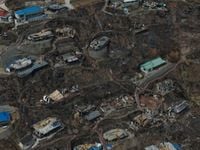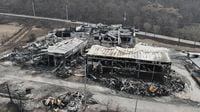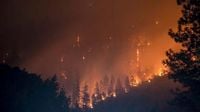The scale of forest damage caused by recent wildfires in North Gyeongsang Province has nearly doubled the initial estimates, according to multiple local governments and authorities. A joint investigation conducted by government agencies, including the Korea Forest Service, revealed that the wildfires that swept across five cities and counties in North Gyeongsang burned close to 90,000 hectares (222,395 acres) of forest. This figure significantly surpasses the initial report of 45,157 hectares that the Korea Forest Service announced after fire suppression efforts concluded.
The actual damage from these wildfires is nearly four times greater than the forest damage caused by the East Coast wildfires in 2000, previously considered the worst in South Korea's history. The term "affected" area refers to the zone within the fire line at the site, which conceptually differs from the "damaged" area determined after suppression is complete. Areas within the fire line that remain unburned are included in the affected area but not in the final damage assessment, meaning that the affected area typically exceeds the actual damaged area. However, in this case, the final damage turned out to be substantially larger, prompting criticism that the Korea Forest Service underestimated the initial extent of the damage.
Authorities are expected to finalize and announce the official size of the forest damage soon. The wildfires, which raged from March 21 for nearly ten days, devastated regions including Uiseong, Andong, Cheongsong, Yeongyang, and Yeongdeok. The impact has been severe, with approximately 4,000 structures destroyed, including the historic Gounsa Temple, a UNESCO World Heritage site, as well as numerous homes and factories.
In addition to the extensive forest damage, the toll on public and private property has been tentatively estimated at 1.13 trillion won (approximately $795 million). The fires caused private property losses of about 509 billion won and public facility damage of roughly 621.6 billion won. Forest-related losses alone accounted for 583.1 billion won, or 94 percent of the public sector damage. The assessments of damage to private property, including homes, crops, and livestock, were extended until April 17 for accuracy.
As the situation continues to unfold, North Gyeongsang Province has stated that the ministries will discuss the final disaster relief and recovery budget, which will be confirmed by the Central Disaster and Safety Countermeasure Headquarters by the end of April or early May. The scale of this disaster has raised concerns among local residents and government officials alike, as they grapple with the aftermath of the wildfires and the extensive damage wrought upon their communities.
Local governments are now facing the daunting task of assessing the full extent of the devastation and planning for recovery efforts. The wildfires have not only destroyed vast areas of forest but have also left many families displaced and in need of support. Community leaders are calling for swift action to provide assistance to those affected and to ensure that recovery efforts are adequately funded and executed.
The wildfires have reignited discussions about the need for better forest management practices and emergency preparedness in South Korea. Many experts are urging the government to invest in more robust fire prevention strategies and to improve coordination among agencies involved in firefighting and disaster response.
As the nation reflects on the severity of this disaster, it is clear that the impact of the wildfires will be felt for years to come. The recovery process will require significant resources and collaboration among government entities, non-profit organizations, and local communities. The hope is that lessons learned from this tragedy will lead to improved safety measures and a more resilient infrastructure to withstand future natural disasters.
In conclusion, the recent wildfires in North Gyeongsang Province have proven to be a catastrophic event, with damage estimates soaring and communities left to pick up the pieces. As authorities work to finalize assessments and develop recovery plans, the focus remains on supporting those affected and preventing such disasters from occurring in the future.






